The Ultimate Strategy for Cleaning Off Stubborn Stovetop Burnt Residue
Posted on 21/06/2025
The Ultimate Strategy for Cleaning Off Stubborn Stovetop Burnt Residue
Struggling to tackle that stubborn burnt residue on your stovetop? You're not alone! It's a universal kitchen woe that can make cooking less enjoyable and your kitchen look a little less inviting. But don't worry--this comprehensive, SEO-optimized guide will give you everything you need to know about cleaning off stovetop burnt-on messes and restoring your range to sparkling condition.
Why Cleaning Burnt Residue Is Crucial for Your Stovetop
Taking the time to clean away burnt residue isn't just a matter of aesthetics. Thick layers of burnt food and grease can:
- Hinder even heat distribution, making cooking less efficient or even burning your food.
- Damage the stovetop surface over time, shortening its lifespan.
- Create stubborn odors that can affect the taste and smell of your dishes.
- Attract pests or bacteria, leading to hygiene issues.

Understanding the Types of Stovetops and Common Residue
Each stovetop type has its own cleaning nuances:
- Gas stovetops: Feature grates and burners that often collect grease and burnt food particles.
- Electric coil stoves: Easily collect drips underneath, especially on drip pans.
- Glass and ceramic stoves: Show burnt marks clearly, requiring special care to avoid scratches.
Burnt-on residue usually forms when spills are left to cook and recook--eventually carbonizing onto your range or cooktop. This hardened layer can prove extremely tricky to remove without the right method!
The Ultimate Step-by-Step Process for Removing Stubborn Burnt Stovetop Residue
Step 1: Gather Your Cleaning Supplies
For the most effective burnt-on residue removal, assemble these tools and cleaners:
- Baking soda - a mild abrasive and natural deodorizer.
- White vinegar - effective at breaking down mineral deposits and burnt food.
- Dish soap - helps lift greasy, oily residue.
- Non-abrasive sponge or microfiber cloth - won't scratch the surface.
- Plastic scraper or old plastic card - for safe scraping on glass or ceramic.
- Razor blade (for glass stovetops only) - used carefully for ultra-tough spots.
- Commercial stovetop cleaner - as a last resort for persistent grime.
- Rubber gloves - protect your skin from harsh chemicals.
Step 2: Cool Down and Prepare the Surface
- Ensure your stovetop is completely cool before you begin!
- Remove any loose debris or crumbs with a dry towel or brush.
- If you have grates or removable burners, take them off and set aside for separate cleaning.
Step 3: Start with a Gentle Soak
For all stovetop types:
- Mix a solution of warm water and dish soap.
- Soak a cloth in the soapy water, wring it out, and lay it over the burnt-on mess for at least 15-20 minutes.
- This helps soften the stubborn residue, making it easier to clean off without damage.
Step 4: Use Baking Soda & Vinegar for Burnt Residue Removal
- Sprinkle baking soda liberally over the burnt area.
- Spray or pour white vinegar over the baking soda.
- Wait for the fizzing action to break down the residue. Allow it to sit for 10-15 minutes.
- Gently scrub using a microfiber cloth or non-abrasive sponge in a circular motion.
- Wipe clean with a damp cloth and dry with a soft towel.
Step 5: Scraping Away Ultra-Stubborn Burn Marks
Stubborn stovetop stains sometimes require gentle scraping--here's how to remove burnt residue without scratching your cooktop:
- For glass and ceramic stoves: Use a new razor blade at a 45-degree angle to carefully scrape up stuck-on residue (always read manufacturer instructions first).
- For metal or gas stovetops: Use a plastic scraper or non-metal spatula to work at residue.
- Never use steel wool or harsh abrasives--they can permanently damage your surfaces.
Step 6: Tackle Removable Parts Separately
Grates, drip pans, or removable burners need special attention:
- Place in a sink or tub filled with hot, soapy water and soak for at least 1 hour.
- Use a stiff brush or non-abrasive sponge to scrub away residue.
- For thick build-up, make a paste of baking soda and water; apply, let sit, and scrub.
- Rinse thoroughly and dry before replacing on your stovetop.
Step 7: Apply a Commercial Stovetop Cleaner (Optional)
If home remedies haven't removed all burnt-on gunk, try a cleaner specifically formulated for your stovetop's material. Always follow product instructions and do a spot test first.
- For glass or ceramic: Use paste-like cleaners made to dissolve burnt residue without scratching (e.g. Cerama Bryte).
- For gas or electric: Look for degreasers or heavy-duty kitchen cleaners (e.g. Bar Keeper's Friend, Easy Off).
Expert Tips for Maintaining a Spotless Stovetop and Preventing Build-up
Now that you've learned how to tackle burnt residue, make future cleanup easier and less frequent with these pro tips:
- Clean spills immediately: Quick wipes after cooking prevent burnt messes.
- Deep clean weekly: Wipe down, remove components, and clean thoroughly at least once a week.
- Use burner liners: Disposable liners can catch drips and make cleaning even easier.
- Avoid harsh cleaners: Stick with mild abrasives like baking soda to maintain the integrity of your stove.
- Check your manufacturer's guide: Always follow specific recommendations for your stovetop model to avoid voiding warranties or causing damage.
Common Mistakes to Avoid When Cleaning Burnt-on Stove Residue
Even with the best intentions, mistakes can happen. For safe and successful stovetop burnt residue cleaning, avoid the following:
- Never use metal scouring pads or steel wool on glass or ceramic: These will scratch and ruin the appearance of your stove.
- Don't let wet cleaners seep into electrical components: Excess moisture can damage your stove or short out parts.
- Don't mix chemicals: Especially bleach and ammonia--dangerous and unnecessary for cleaning burnt food.
- Don't pry with sharp tools: Using knives or chisel-like tools risks deep scratches.
Myths and Truths About Cleaning Burnt Stovetop Residue
-
Myth: You need harsh chemicals to remove burnt-on food.
Truth: Natural solutions (like baking soda and vinegar) are gentle and effective without the fumes! -
Myth: Scraping is always safe.
Truth: The wrong scraper can ruin your stovetop--always use plastic or a proper razor (for glass). -
Myth: Leaving residue overnight will make it easier to remove.
Truth: The longer it sits, the harder it is to get off! Tackle it as soon as possible.
Frequently Asked Questions About Cleaning Stovetop Burnt Residue
-
How do I prevent burnt residue in the first place?
Wipe up spills immediately and use burner liners whenever possible. Always cook with appropriate-sized pots to minimize drips. -
Is it safe to use a razor blade on all stovetops?
No--only use a razor blade on glass or ceramic cooktops, and always check your manufacturer's guidelines. -
Can I use oven cleaner on my stovetop?
Some stovetop materials can be damaged by harsh oven cleaners, so always test a small area first or consult your user manual. -
What's the best way to clean gas stove grates?
Soak in hot, soapy water, scrub with a non-abrasive brush, or use a paste of baking soda and water for thick residue. -
Are commercial stovetop cleaners worth it?
For extremely stubborn, burnt-on residue that natural solutions can't tackle, they can be very effective. Just use as directed.

The Bottom Line: Stovetop Burnt Residue Removal Can Be Easy!
With the right technique and regular maintenance, cleaning off even the most stubborn stovetop burnt residue becomes a simple, safe process. Use natural cleaners, avoid abrasive pads, and act quickly when spills occur. Not only will your stove stay looking like new, but you'll also make your kitchen healthier and more enjoyable to use.
Summary: Your Go-To Guide for a Pristine Stovetop
- Use soaking, baking soda and vinegar, and gentle scraping for optimal results.
- Avoid harsh pads and chemicals that can damage your stovetop.
- Prevent burnt-on build-up with regular cleaning and quick spill removal.
- Consult your appliance manual for cleaning dos and don'ts specific to your stovetop.
Tired of scrubbing? Try this ultimate stovetop burnt residue cleaning strategy today, and enjoy a kitchen that's as clean as it is welcoming!




